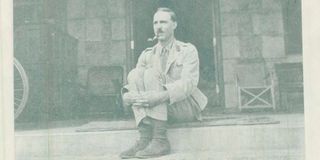
Agnes Wanjiru, who was found dead in 2012 after she went missing.
Much has been written about the failure to prosecute the killer of 21-year-old Agnes Wanjiru, the Nanyuki woman allegedly murdered by a British soldier from the Duke of Lancaster Regiment – and the cover-up that followed.
Yet, this case is part of a broader historical pattern. It follows the logic of colonial settler violence, which rested on an imagined right to dominate and suppress and still thrives in some colonised frontiers – Nanyuki included.
It is the same impunity that Richard Meinertzhagen, a British colonial officer, had when he carried out cold-blooded executions to impose his will on the people. His most infamous act was the execution of Koitalel arap Samoei, the Nandi leader, in 1905.

British colonial officer Richard Meinertzhagen in Nairobi in 1915.
Beyond direct killings, Meinertzhagen promoted a doctrine of racial superiority and violence as a means of control. He documented his “exploits” in his diaries, often boasting about killing and the manipulation of African leaders.
The Meinertzhagen mentality and impunity are at play in the Wanjiru case. Wanjiru was last seen leaving the Lions Court Hotel, Nanyuki, with a known British soldier on the night of March 31, 2012.
Her body was found in a septic tank four months later. The pursuit of justice has remained trapped in an endless cycle – brief moments of public outrage followed by bureaucratic inertia, with no meaningful action taken against the said perpetrator. This, too, is unsurprising.
Wanjiru’s case is a continuation of British settler violence, which was often met with impunity. Nanyuki remains a stronghold of settler colonial legacies, with its no-go zone farms, fenced water points and closed public roads serving as reminders of an enduring and unchallenged history of exclusion and privilege.
Sentenced to death
Given the history of extra-judicial killings and outright murders, it surprises some that it was only in 1959 – at the tail end of colonial rule – that a Briton was found guilty of killing an African and sentenced to death.
That is why the case of Rex vs Peter Poole is important. More so, Poole’s later hanging occurred only when Britain had already accepted the inevitable: Kenya would not become the “White Man’s Country” that Lord Delamere had envisioned, as chronicled in Elspeth Huxley’s biography of the settler leader. But that did not come easily.

Portrait of Koitalel arap Samoei, Nandi leader in the museum in Nandi Hills Town. Photo | Rupi Mangat
Poole was a familiar name in Nairobi’s colonial circles. Norman Poole, the family patriarch, ran Poole & Son, an electrical shop on Government Road (now Moi Avenue). His son Peter, had a reputation of his own – described by one writer as an “irascible and arrogant young man”.
That reputation was not without cause. Poole had once pulled a gun on a shopkeeper for refusing to give him a discount on a torch. In another incident, he shot an African police constable in the leg while the officer was being attacked by Poole’s dogs.
Despite these outbursts, the justice system had let him walk free.
Shot Musunge dead
But Poole went a step too far on October 12, 1959. He was charged with the murder of Kamawe Musunge, a cyclist who had been riding on Ngong Road near Adams Arcade when Poole’s Alsatian dogs attacked him.
In the altercation that followed, Poole emerged from his house, raised his gun and shot Musunge dead.
To many White settlers, Poole was one of their own – a man who, in their view, should not stand trial for killing a Black person. But the case was too blatant to ignore.
Peter Poole was formally arraigned for murder on November 30, 1959. A jury of 12 was sworn in. The trial took an unexpected turn as the prosecution prepared to call its first witness.
One of the jurors stood and told the court that he had a “conscientious objection to giving a verdict of guilty in the case on religious grounds”.
Rather than dismiss the juror and proceed with the remaining 11, the prosecution took the unusual step of entering a nolle prosequi – a formal decision to discontinue the case.

Agnes Wanjiru, who was found dead in 2012 after she went missing.
Peter Poole was immediately discharged. This was followed by an uproar from a nation that was negotiating its path to independence.
For the first time, justice, it seemed, was not ready to give up. According to court records, a deputy registrar approached Poole and said: “Would you follow me?”
The two walked into an anteroom, where Poole was promptly served with a new warrant for his arrest – reigniting the efforts of the prosecution.
What followed was a heated legal battle. Could a new case proceed after a nolle prosequi had been entered? Defence lawyers argued that the initial charge had effectively collapsed, and that no fresh complaint had been made. Poole, they said, had been arrested without a warrant and had not been properly presented before a magistrate.
As a result, they contended, any further legal proceedings – including arraignment, trial or sentencing – would be unlawful.
The Peter Poole case exposed tensions in the colonial justice system and sparked outrage.
At its heart was a question that cut to the core of public confidence in the rule of law: Could a White man get away with killing a Black man in broad daylight – and walk free on a technicality?
This was a case whose determination would restore people’s faith in the judicial system, which had during the State of Emergency sentenced many Africans to death for simply possessing a firearm.
In gripping courtroom testimony, witness Titoro Sabai described the final moments of Musunge’s life, bringing moments that would haunt the conscience of a nation grappling with the brutal realities of colonial violence.
Sabai told the court that after Musunge was attacked by Poole’s dogs, “he picked up some soil and threw it at the dogs,” to fend off the attack.
When the dogs retreated, Poole came out of his house, calling them to follow.
By then, Musunge was simply walking – Sabai said – pushing his bicycle and holding a pump in one hand.
“Poole walked up to the hedge of the neighbouring house, grabbed the bicycle, then pulled a pistol from his pocket,” Sabai testified.
“He pulled the trigger – and the second shot struck Musunge who dropped the bicycle and ran towards the corner of the hedge, clutching his stomach and bending over.”
Killing a black man
Musunge collapsed and died at the scene as Peter Poole stood and watched.
Finally, and for the first time, a White man was hanged for killing a Black man. There were many petitions and signature collections to save the killer.
Poole’s father had even approached politician Tom Mboya for support. Mboya refused to be drawn into the matter.
Gun violence was normalised in colonial Kenya. The firearm was not just for protection of perceived White superiority but also symbolised authority and domination.
The gun in Poole’s hands was an extension of the settler’s entitlement – licensed, literally and socially, by a colonial structure that viewed African life as expendable. That is how we still look at Wanjiru’s murder.
The cover-up is a re-enactment of the same colonial mentality that operated on a logic that treated the settler’s violence as lawful or, at worst, forgivable.
When Poole shot Musunge, it was not an anomaly – it was the logical outcome of a system that had long legitimised such acts.
Poole’s actions echoed a broader pattern where White settlers, especially men, policed space and behaviour through force, often using guns.
In the Wanjiru case, the pattern of impunity displayed by British soldiers mirrors the injustices inflicted upon the community since the days of Meinertzhagen.
While Poole’s trial and execution should have symbolised the beginning of the end of racially based impunity, the Wanjiru case instead reveals the troubling persistence of Meinertzhagen-style colonial disorder.
John Kamau is a doctorate candidate in History, University of Toronto, Canada. Email: [email protected] @johnkamau1











